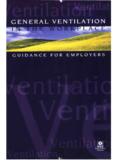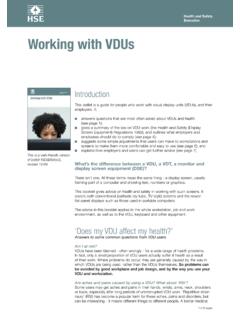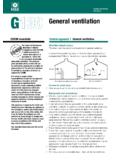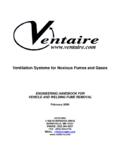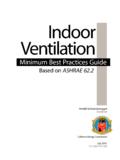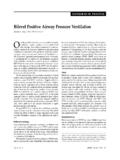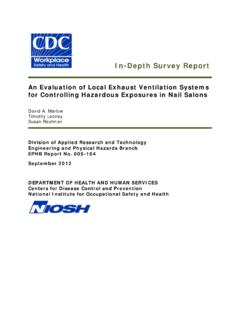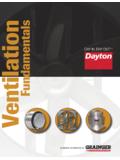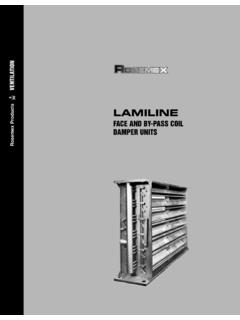Transcription of GENERAL VENTILATION - UCU - Home
1 GENERAL VENTILATION . G U I D A N C E F O R E M P L O Y E R S. HSG202. Crown copyright 2000. Applications for reproduction should be made in writing to: Copyright Unit, Her Majesty's Stationery Office, St. Clements House, 2-16 Colegate, Norwich NR3 1BQ. First published 2000. ISBN 0 7176 1793 9. All rights reserved. No part of this publication may be reproduced, stored in a retrieval system, or transmitted in any form or by any means (electronic, mechanical, photocopying, recording or otherwise) without the prior written permission of the copyright owner. This guidance is issued by the Health and Safety Executive. Following the guidance is not compulsory and you are free to take other action. But if you do follow the guidance you will normally be doing enough to comply with the law. Health and safety inspectors seek to secure compliance with the law and may refer to this guidance as illustrating good practice. ii CONTENTS.
2 INTRODUCTION 1. WHAT IS GENERAL VENTILATION ? 1. WHY IS FRESH AIR REQUIRED IN THE. WORKPLACE? 1. Health effects of insufficient fresh air 2. PRINCIPLES OF NATURAL VENTILATION 3. WHEN TO USE GENERAL VENTILATION 4. Use of recirculated air 5. Emergencies 6. STANDARDS OF GENERAL VENTILATION 6. Factories, hospitals, laboratories etc 6. Offices, shops, theatres etc 8. Standards for gas, coal or oil fired equipment 8. Air movement 8. HOW TO ACHIEVE EFFECTIVE. VENTILATION IN YOUR WORKPLACE 8. ASSESSING THE EFFECTIVENESS OF. YOUR VENTILATION SYSTEM 10. Maintenance of mechanical VENTILATION systems 11. WHAT THE LAW REQUIRES YOU TO DO 12. REFERENCES 13. FURTHER INFORMATION 14. HSE Publications 14. British Standards Institution Publications 14. Other publications 14. Useful organisations 15. iii 4 This guide does not deal with systems for INTRODUCTION. controlling smoke and combustion products 1 Everyone working in offices, shops, from accidental fires or the consequences of factories, hospitals, laboratories etc requires a condensation and mould growth.
3 Minimum standard of fresh air to produce a healthy working environment. One way that WHAT IS GENERAL . this can be provided is by effective GENERAL VENTILATION . This guidance is aimed at VENTILATION ? employers to help them understand the 5 GENERAL VENTILATION or 'dilution' VENTILATION benefits and limitations of effective GENERAL VENTILATION in the workplace. is a term used to define the flow of air into and out of a working area, for example an office 2 This guide defines GENERAL VENTILATION and space, so that any contaminants are diluted by gives information on fresh air requirements. It adding some fresh air. This can be provided by: also looks at the principles and use of GENERAL Natural VENTILATION which relies on wind VENTILATION as a means of controlling exposure pressure and temperature differences to to substances hazardous to health as required move fresh air through a building and is under the Control of Substances Hazardous to 1 usually not fully controllable; and Health Regulations (COSHH) 1999 and the associated Approved Codes of Practice2.
4 It 'Forced' or mechanical VENTILATION which uses gives the current VENTILATION standards and mechanical supply and/or extraction to advises you, the employer, on how to achieve provide fresh air and is controllable effective GENERAL VENTILATION in your workplace. (see Figure 1). It outlines the methods used to assess the effectiveness of your VENTILATION system and WHY IS FRESH AIR. sets out the legislation on what you are REQUIRED IN THE. required to do to ensure effective VENTILATION . The guide also tells you where to get further WORKPLACE? information and help. 6 You need to provide fresh air to: 3 This guide does not deal with VENTILATION of: provide oxygen for breathing in and to processes requiring local exhaust remove carbon dioxide from breathing out;. VENTILATION (LEV);. remove excess heat or, if conditioned, some specialised premises, for example provide heat eg in winter and keep a livestock buildings, confined spaces, mines comfortable temperature.
5 Or flammable stores; or dilute and remove body and other types of domestic premises. odours (eg food); and 1. Extractor fan in roof Fresh air supply fan in wall Figure 1: Mechanical VENTILATION using fans to supply and extract air dilute any contaminants caused by filtered to remove particulates, and should workplace activities (ie the use of 'dilution' have fresh air added to it before being VENTILATION following a risk assessment). reintroduced into the workplace. 7 Fresh air is 'clean' air which has come from a 9 When providing fresh air for your source outside the workplace. The main employees, make sure there are no constituents of dry air by volume are: uncomfortable draughts from the movement of air. nitrogen Health effects of insufficient fresh air oxygen inert gases 10 Insufficient fresh air may lead to tiredness, carbon dioxide lethargy, headaches, dry or itchy skin and eye (300 parts per million) irritation in your employees.
6 These symptoms may also be produced whilst working in poorly designed buildings and offices and where 8 The fresh air' which is brought into your there are unsatisfactory working conditions, for workplace should be free of contaminants such example the inability of workers to control as engine exhaust emissions, or discharges certain aspects of their work. The symptoms from oil or gas fired flues or extract outlets. If are generally worse in buildings where there is you expect the inlet air to be heavily not enough fresh air. These are common contaminated with particulates (eg heavy symptoms of what is generally known as 'sick traffic, smoke etc) then it should be filtered. Air building syndrome' (SBS). to be recirculated should be adequately 2. 11 The HSE publication How to deal with sick pressure differences in a building create an building syndrome3 gives information on the upward movement of air or stack' effect.
7 Causes of SBS and guidance on how to Occasionally, there can be downward air prevent it. movement if the air is cold. 14 Wind forces are affected by wind speed, PRINCIPLES OF wind direction and the shape of the building. NATURAL VENTILATION Cross- VENTILATION occurs when wind blows air through a room or building which has openings, 12 A basic knowledge of the principles of for example windows on opposite sides natural VENTILATION can help you understand (see Figure 2). Single-sided VENTILATION occurs how to use GENERAL VENTILATION as a way of when there are one or more openings (such as controlling exposure to contaminants produced a window and a door] on one side only. in the workplace. 15 Stack VENTILATION may be effective enough 13 Natural VENTILATION is produced by the to carry vapours generated by small-scale hot effects of temperature and changes in air industrial processes upwards. They can then pressure ie wind.)
8 Temperature and air be removed through the roof via roof Air passes through building via open windows to remove contaminants Air enters through open windows Windows closed Air becomes stagnant if windows and doors shut Figure 2. Cross- VENTILATION to remove contaminants in an office building 3. Vapour laden air rises to roof where it accumulates or escapes through roof vent If VENTILATION is not sufficient, the vapour will collect in the roof space or drift back down Vapour which does not escape may hang in stratified layer Cool air enters at low level through Cool air enters at open windows low level through open windows Hot process producing fumes Figure 3: Stack VENTILATION to remove vapours through roof ventilators ventilators or extraction fans. If cooler air comes HSE publication Thermal comfort in the in at a low level, it will displace the warm rising 17 You may consider using effective natural contaminated air, ie displacement VENTILATION and/or mechanical GENERAL VENTILATION to (see paragraph 20)(see Figure 3).
9 Provide the fresh air supply. 18 As an employer, if you carry out industrial or WHEN TO USE non-industrial work processes (eg hairdressing, GENERAL VENTILATION catering) you will be required to undertake a risk assessment under the COSHH Regulations. 16 To ensure a well ventilated workplace you This means assessing the risks to health of your should provide GENERAL VENTILATION that removes employees who may be potentially exposed to stale, contaminated, or hot and humid air so that substances hazardous to health. You may then your employees do not suffer any ill-health need to prevent or adequately control such effects. There is guidance on how you can exposure. ensure thermal comfort at your workplace in the 4. 19 If the contaminant is of such a low toxicity the contaminant has a low toxicity (see the and produced in such low concentrations that it Chemicals (Hazard Information and would be impractical and costly to use local Packaging for Supply) (Amendment).)
10 Exhaust VENTILATION , you may decide to use Regulations 19996);. GENERAL VENTILATION as part of your control the contaminant is produced at a strategy (see HSE publication COSHH. uniform rate;. Essentials).5 However, if there are a small number of well-spaced contaminant sources, the workers are positioned at 90 to the air using LEV may be more cost effective than flow (the contaminant air must not be drawn GENERAL VENTILATION (see Figure 4). There may or blown towards the faces of be instances where intermittent exposure to a the operatives);. substance exceeds the assigned Occupational the contaminant is generated in low Exposure Limit (OEL), for example during concentrations and can be controlled to the welding and paint spraying. In this case, you assigned OEL (see HSE publication should consider using LEV to control exposure. EH40/2000 7 ) ; and 20 When you use GENERAL VENTILATION to control the air flow does not affect the performance exposure to contaminants generated from of other extraction systems eg fume industrial processes, it is essential that: cupboards, LEV.
